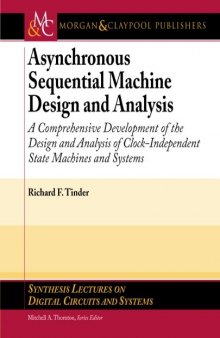 جزییات کتاب
جزییات کتاب
Asynchronous Sequential Machine Design and Analysis provides a lucid, in-depth treatment of asynchronous state machine design and analysis presented in two parts: Part I on the background fundamentals related to asynchronous sequential logic circuits generally, and Part II on self-timed systems, high-performance asynchronous programmable sequencers, and arbiters. Part I provides a detailed review of the background fundamentals for the design and analysis of asynchronous finite state machines (FSMs). Included are the basic models, use of fully documented state diagrams, and the design and characteristics of basic memory cells and Muller C-elements. Simple FSMs using C-elements illustrate the design process. The detection and elimination of timing defects in asynchronous FSMs are covered in detail. This is followed by the array algebraic approach to the design of single-transition-time machines and use of CAD software for that purpose, one-hot asynchronous FSMs, and pulse mode FSMs. Part I concludes with the analysis procedures for asynchronous state machines. Part II is concerned mainly with self-timed systems, programmable sequencers, and arbiters. It begins with a detailed treatment of externally asynchronous/internally clocked (or pausable) systems that are delay-insensitive and metastability-hardened. This is followed by defect-free cascadable asynchronous sequencers, and defect-free one-hot asynchronous programmable sequencers--their characteristics, design, and applications. Part II concludes with arbiter modules of various types, those with and without metastability protection, together with applications.



 دانلود کتاب
دانلود کتاب

 جزییات کتاب
جزییات کتاب
 این کتاب رو مطالعه کردید؟ نظر شما چیست؟
این کتاب رو مطالعه کردید؟ نظر شما چیست؟
